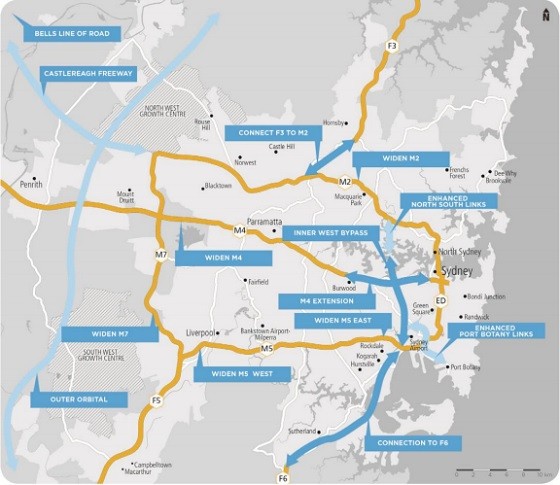
The government was criticised by some talking heads last night for not taking the opportunity in the budget to give greater emphasis to the differences between Labor values and Coalition values.
One area, though, where there’s now a clear distinction between the two contenders is public transport. The budget surprised with funding for three rail projects:
- $0.71 billion for the Brisbane Cross River Rail.
- $3.0 billion for the Melbourne Metro.
- $0.5 billion for Perth Light Rail (or construction of a new rail link to the city’s airport).
This creates a strong contrast with the Coalition. Tony Abbott has already made it very clear he thinks the Commonwealth’s role in cities should be limited to funding roads, not public transport.
He’s promised $1.5 billion for Melbourne’s proposed East-West Link road tunnel and another $1.5 billion for Sydney’s proposed WestConnex freeway, but he says there’s no historical basis for Commonwealth involvement in funding urban rail lines.
The promises on both sides smack loudly of political strategy, not good public policy.
The East-West Link and WestConnex are both at an early stage in Infrastructure Australia’s four stage priority list. Their Benefit Cost Ratios are uncertain and in the case of the former is thought by many observers to be negative.
The Melbourne Metro and Cross River Rail projects look a lot more responsible. They are both in Infrastructure Australia’s final Ready to Proceed category and both have positive Benefit Cost Ratios (1.3).
However the status of the two alternative Perth projects is unclear – neither of them is on Infrastructure Australia’s priority list. The fact that Commonwealth funding is provided on an ‘either/or’ basis for two entirely separate projects suggests to my jaded eyes that politics is the main driver of the decision.
The Government’s funding for the rail projects is on a matching basis with the States and is spread over a number of years. It’s unlikely much of the funding would be paid down by 2016-17, so it’s not clear that it’s even budgeted in the practical sense. It looks like smoke and mirrors.
The private sector is also assumed to be a major contributor of capital. Budget Paper No 1 has a lot to say about the importance of private sector involvement in infrastructure provision, e.g.
The Government is also looking to utilise new funding and financing arrangements to help attract private sector involvement in the Melbourne Metro and Brisbane Cross River Rail ‘mega projects’.
Investors would most likely be involved via “availability payments”. This approach minimises government borrowings but also minimises the risk borne by investors.
The result is taxpayers pay more – probably much more – than they would if governments borrowed directly. It appears the Commonwealth is prepared to fund half the availability payments, effectively boosting it’s offer in the case of Melbourne Metro to half the total $9 billion cost.
The promised funding presents the Premiers with some interesting choices.
For example, Denis Napthine says both the $6-$8 billion East-West Link and the $9 billion Melbourne Metro are the State’s highest transport infrastructure priorities.
He’s already committed State funding to the East-West Link from next year’s budget but only provided a mere $10 million for more planning work on Melbourne Metro. He says the 9 km rail line isn’t ready to proceed yet because the business case hasn’t been finalised.
That’s a doubtful assertion that might be tested by the Commonwealth’s offer. As well as $3 billion in Commonwealth funding and $3 billion from private investors, the Metro would require Mr Napthine to find $3 billion from State sources.
Last night’s budget also provides funding for major urban road projects:
- $0.72 billion to upgrade and widen Brisbane’s Gateway North Motorway
- $0.52 billion to complete the widening of Melbourne’s M80 Ring Road.
- $1.8 billion for WestConnex.
- $0.4 billion to build a tunnel linking the F3 with the M2.
- $0.45 billion to upgrade South Road, Adelaide.
There’s nothing for the East-West Link though, presumably sharpening the choice for Melburnians between Labor (rail) and the Coalition (road).
The triumph of politics over policy is stark. None of the new road projects are in Infrastructure Australia’s Ready to Proceed category, or even the preceding Threshold category.
So far as Infrastructure Australia is concerned they still require finalisation of a detailed business case i.e. it hasn’t yet been established that they’re sensible projects.
The government’s offer for WestConnex is bigger than Mr Abbott’s $1.5 billion promise, but comes with the same undesirable condition that it connects to the CBD.
It also requires that “new tolls are not imposed on existing un‑tolled roads”. That’s unfortunate because it reduces funding options and makes the introduction of road pricing down the track harder.
Of course this might all be academic. The general consensus of the talking heads on TV and radio last night was that come 14 September the Gillard government will be gone for all money.
I don’t know what the Premiers of Victoria and Qld can do between now and September to lock in Commonwealth funding for rail projects and it must be tempting to haggle over the size of the Commonwealth contribution.
But I expect they’d each put their state’s interest ahead of federal politicking. They have an opportunity to pursue funding for these projects with both Julia Gillard and Tony Abbott. An opportunity like this isn’t likely to come round again any time soon.
Brisbane’s Cross River Rail and Melbourne’s Metro are good projects and warrant funding, but they look like a lucky break and there’s the suspicion the funding is an apparition. Spending on transport infrastructure in the budget is driven more by smart politics than good policy.
Given that the budget required some hard decisions, I’d dared to hope that indexation of the petrol excise might’ve been reinstated. It’s been stuck at 38.1 cents since John Howard abolished indexation in 2001. It would otherwise be around 50 cents now and bringing in more revenue. No such luck.
I didn’t have the luxury of participating in yesterday’s budget lock-up, so I’ll have a closer look at the budget papers over the next day or two to see what else there might be that’s of direct relevance to urban policy.
Update: More budget detail:
Nation-building infrastructure
Projects announced in 2013-14 budget








Crikey is committed to hosting lively discussions. Help us keep the conversation useful, interesting and welcoming. We aim to publish comments quickly in the interest of promoting robust conversation, but we’re a small team and we deploy filters to protect against legal risk. Occasionally your comment may be held up while we review, but we’re working as fast as we can to keep the conversation rolling.
The Crikey comment section is members-only content. Please subscribe to leave a comment.
The Crikey comment section is members-only content. Please login to leave a comment.